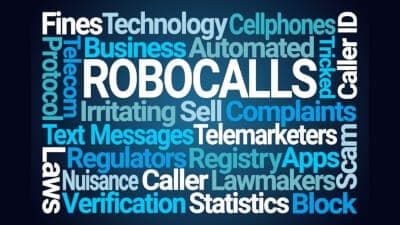Robocall prevention
Robocalls are overwhelming the telephone network. New laws and regulations, and increasing market demand, require voice service providers to respond.
- Enterprise customers want you to block or divert inbound robocalls that can tie up their phones and cripple their business.
- Consumers want you to block or divert annoying scam robocalls.
TransNexus offers a suite of software solutions that enable you to protect your enterprise and residential customers from receiving unwanted, disruptive robocalls. These robocall prevention solutions include:
- SIP Analytics
- Phone number reputation lookup
- Blacklisting to prevent neighbor-spoofing
- Customer-maintained blacklists
- Shield detection of high-risk and invalid numbers
- STIR/SHAKEN call authentication
SIP Analytics
SIP Analytics monitors call traffic from specific calling numbers. If the number of calls from a number exceeds thresholds, then the software will perform the action you chose during setup: either block the call, divert it to another call handling system (like our CAPTCHA gateway), or complete the call and log it in a report for your review.

Phone number reputation lookup
This service checks the reputation of the calling number using crowdsourced databases of robocall caller IDs.
With the phone number reputation lookup, you can set up policies that will either block call from a number with poor reputation, divert it, or report only. For example, some carriers have set it up to divert calls from a low-reputation calling number to the customer’s voicemail. Alternatively, you could divert such calls to a CAPTCHA gateway.
Blacklisting to prevent neighbor-spoofing
The whitelist/blacklist service has powerful capabilities that can be used for a variety of purposes. One use is to screen calls when the calling number is like the called party’s number, a robocall tactic called neighbor spoofing.
You can blacklist calls that arrive at your peering SBC where the calling number is assigned to your OCN/SPID. Normally, such calls would be internal to your network. If they arrive from the external network at the edge of your network, they probably involve neighbor spoofing. Blacklisting your own OCN/SPID at the edge of your network can block a lot of robocalls.
You can set up the blacklist to divert such calls to a CAPTCHA gateway.
Customer-maintained blacklists
Our software products provide APIs (application program interface) that you can use with your customer web portal to allow your customers to set up their own blacklists. You would need a web portal that authenticates subscribers before they can enter a request to block calls to their number from a specific calling number.
Shield detection of high-risk and invalid numbers
TransNexus maintains a database of high-risk numbers compiled from many sources. These numbers include premium-rate numbers, for example, and numbers known to be used in robocalls. You can enable the Shield service to block, divert or report those calls to protect yourself from robocalls and fraud attacks.
The Shield service can also identify invalid calling numbers. You can configure similar responses when such calls are detected. For example, the CRTC has mandated that terminating service providers in Canada block calls with invalid calling numbers. The Shield service makes this easy.
STIR/SHAKEN call authentication
STIR/SHAKEN is a framework where the originating service provider attests to the validity of caller ID information and adds a cryptographically-signed caller ID authentication. At the other end of the call path, the terminating service provider checks the attestation, verifies the cryptographic signature and presents the verification status to the called party.
Call authentication makes called parties trust authenticated caller ID. They’re more likely to answer such calls. Call authentication also makes the other robocall analytics methods above more effective.
Get started today
Let us show you how easy it can be to get started with robocall prevention. Contact us today to learn more.
More on TransNexus.com
December 3, 2025
STIR/SHAKEN statistics from November 2025
November 4, 2025
STIR/SHAKEN statistics from October 2025
October 28, 2025
FCC adopts proposed rules for presentation of caller name
October 14, 2025
FCC proposes new STIR/SHAKEN caller identity rules
October 6, 2025
STIR/SHAKEN statistics from September 2025
September 11, 2025
Third-party SHAKEN rules deadline almost here
August 20, 2025
Reply comments on FCC proposed rules for non-IP SHAKEN
August 19, 2025
Effective date set for FCC third-party SHAKEN rules
August 7, 2025
FCC removes 185 deficient RMD certifications
July 7, 2025
Comments on FCC proposed rules for non-IP SHAKEN
June 16, 2025
Comment dates set for FCC non-IP SHAKEN rules
May 2, 2025
FCC adopts Notice of Proposed Rulemaking on non-IP SHAKEN
April 7, 2025
FCC to vote on a non-IP call authentication mandate
February 25, 2025
New Out-of-Band SHAKEN standard published
November 22, 2024
FCC adopts new rules for third-party SHAKEN
November 22, 2024
Webinar recording — Branded Calling for Service Providers
November 4, 2024
FCC proposes new STIR/SHAKEN rules on third-party signing
August 28, 2024
Lingo FCC compliance plan and lessons for other providers
May 29, 2024
Originating provider fined for improper attestation
April 17, 2024
TelWare uses ClearIP to protect their customers from robocalls.
Learn more about this case study